小学形容词副词讲解
- 格式:ppt
- 大小:325.00 KB
- 文档页数:26

小学英语语法形容词副词的用法总结整理归纳形容词是用来描述事物的特征和性质的词语,而副词则用来描述动作的方式、程度、时间等。
下面是小学英语形容词和副词的用法总结:形容词的用法:1. 形容词一般置于名词之前,用来修饰名词。
例如:a big house (一座大房子),a happy girl(一个快乐的女孩)。
2. 形容词可以用于比较级和最高级。
比较级用来比较两个事物的不同,最高级用来比较三个或以上事物的不同。
例如:This book is bigger than that one(这本书比那本大);He is the tallest boy in the class(他是班级里最高的男孩)。
3. 形容词可以和"be"动词连用,表示事物的状态或性质。
例如:She is beautiful(她很漂亮)。
副词的用法:1. 副词可以修饰动词,表示动作的方式、程度等。
例如:He runs quickly(他跑得很快)。
2. 副词可以修饰形容词,表示形容词程度的大小。
例如:She is very beautiful(她非常漂亮)。
3. 副词可以修饰其他副词,表示副词的程度。
例如:He reads quite slowly(他读得相当慢)。
4. 副词也可以修饰整个句子,表示说话人的态度或观点。
例如:Certainly, I will help you(当然,我会帮助你)。
需要注意的是,有一些形容词和副词的形式是相同的,需要根据具体情况来判断其词性。
同时,有些形容词和副词可以通过在词尾加上"-ly"来转化为副词形式。
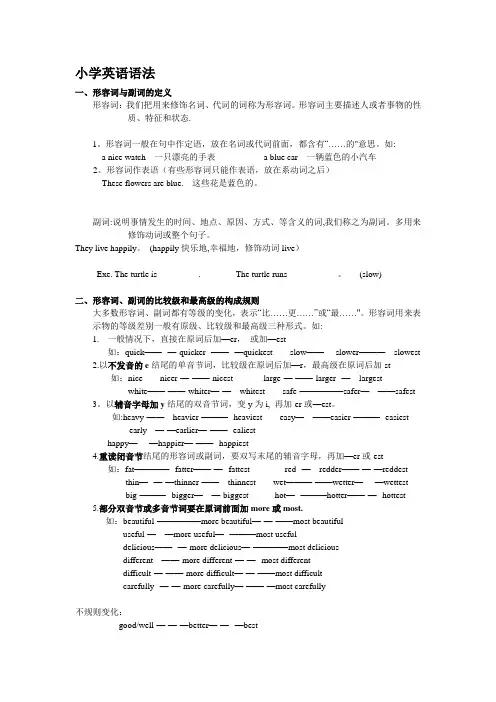
小学英语语法一、形容词与副词的定义形容词:我们把用来修饰名词、代词的词称为形容词。
形容词主要描述人或者事物的性质、特征和状态.1。
形容词一般在句中作定语,放在名词或代词前面,都含有“……的"意思。
如:a nice watch 一只漂亮的手表 a blue car 一辆蓝色的小汽车2。
形容词作表语(有些形容词只能作表语,放在系动词之后)These flowers are blue. 这些花是蓝色的。
副词:说明事情发生的时间、地点、原因、方式、等含义的词,我们称之为副词。
多用来修饰动词或整个句子。
They live happily。
(happily快乐地,幸福地,修饰动词live)Exe. The turtle is _________. The turtle runs ___________。
(slow)二、形容词、副词的比较级和最高级的构成规则大多数形容词、副词都有等级的变化,表示“比……更……”或“最……"。
形容词用来表示物的等级差别一般有原级、比较级和最高级三种形式。
如:1.一般情况下,直接在原词后加—er,或加—est如:quick——--—-quicker--——--—quickest slow——----slower———---slowest2.以不发音的e结尾的单音节词,比较级在原词后加—r,最高级在原词后加-st如:nice------nicer-—-——-nicest large-—-——-larger--—---largestwhite——-——-whiter—-—---whitest safe-—————safer—---——safest 3。
以辅音字母加y结尾的双音节词,变y为i, 再加-er或—est。
如:heavy-——---heavier-———--heaviest easy—---——easier-———--easiest early---—-—earlier—-——--ealiesthappy—----—happier—-——--happiest4.重读闭音节结尾的形容词或副词,要双写末尾的辅音字母,再加—er或-est如:fat————--fatter——-—--fattest red--—---redder——-—-—reddest thin—--—-—thinner-——---thinnest wet———-——wetter—----—wettestbig-———--bigger—---—-biggest hot—--———hotter——-—--hottest5.部分双音节或多音节词要在原词前面加more或most.如:beautiful-—————more beautiful—-—-——most beautifuluseful-—---—more useful—--———most usefuldelicious——--—-more delicious—-————most deliciousdifferent---——-more different-—-—--most differentdifficult-—-——-more difficult—-—-——most difficultcarefully--—-—-more carefully—-——-—most carefully不规则变化:good/well-—-—-—better—-—--—bestbad—--———worse---———worstmany/much—----—more—-———-most little———-—-less-————-leastfar—--——-farther—————-farthest (指距离的远近)far-—-——-further——--——furthest (表示程度上更进步)old—---—-older---—--oldest (表示年纪大)old--——-—elder-——-——eldest (表示长幼关系)三、形容词、副词比较级的用法表示两者间的比较用比较级。
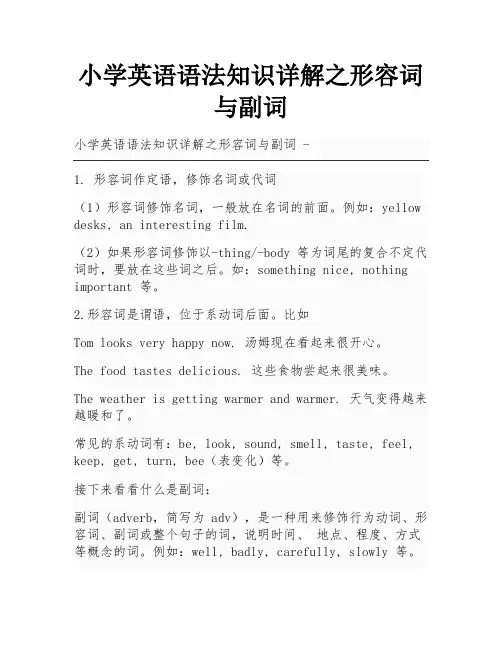
小学英语语法知识详解之形容词与副词1. 形容词作定语,修饰名词或代词(1)形容词修饰名词,一般放在名词的前面。
例如:yellow desks, an interesting film.(2)如果形容词修饰以-thing/-body 等为词尾的复合不定代词时,要放在这些词之后。
如:something nice, nothing important 等。
2.形容词是谓语,位于系动词后面。
比如Tom looks very happy now. 汤姆现在看起来很开心。
The food tastes delicious. 这些食物尝起来很美味。
The weather is getting warmer and warmer. 天气变得越来越暖和了。
常见的系动词有:be, look, sound, smell, taste, feel, keep, get, turn, bee(表变化)等。
接下来看看什么是副词:副词(adverb,简写为 adv),是一种用来修饰行为动词、形容词、副词或整个句子的词,说明时间、地点、程度、方式等概念的词。
例如:well, badly, carefully, slowly 等。
(对于什么是副词,也同样是运用跟汉语相联系的办法,前面说形容词就是带“的”的词,那么副词就是带“地”或者“得”的词了,我们知道在汉语中带“地”的词后面都是接动词,也就意味着英语中汉语解释带“地”的词也是用来修饰动词的,这样既可以很好的理解什么是副词也能顺便把副词的基本用法了解了,一举两得。
对于带“得”的词,在汉语中一般是接形容词的,比如说:开心得不得了,可以看得出“开心”是形容词,而“不得了”是修饰开心的程度的,于是中文含义带有“得”的词就是副词,且是用来修饰形容词或者副词的程度的)副词的分类方式副词: 表示动作和状态的进行和存在方式、方法,如:carefully, suddenly, fast, well, politely,但friendly lovely, lonely, lively elderly, ugly 为形容词程度副词: 多用来修饰形容词和副词,如:very ,much,enough,almost,rather,so,too,still,quite地点副词:here ,there ,everywhere, anywhere, home, upstairs, downstairs 等时间副词:tomorrow, now, today, then, yesterday, tonight 等频度副词:always,usually,often,never,sometimes,seldom,once,rarely,hardly 等疑问副词:why, when, where, how(引导特殊疑问句) how often, how long ,how soon, how much, how many 等关系副词:when, where, why (用于定语从句)其他also,either,too,only,perhaps(对于疑问副词和关系副词,小学不用做要求,认识就行!)接下来看看副词的基本用法:(1)修改行为动词以显示动作是如何执行的。
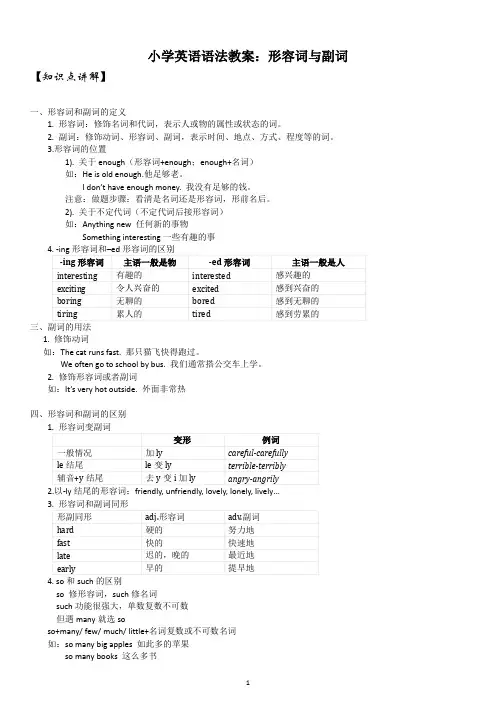
小学英语语法教案:形容词与副词【知识点讲解】一、形容词和副词的定义1. 形容词:修饰名词和代词,表示人或物的属性或状态的词。
2. 副词:修饰动词、形容词、副词,表示时间、地点、方式、程度等的词。
3.形容词的位置1). 关于enough(形容词+enough;enough+名词)如:He is old enough.他足够老。
I don’t have enough money. 我没有足够的钱。
注意:做题步骤:看清是名词还是形容词,形前名后。
2). 关于不定代词(不定代词后接形容词)如:Anything new 任何新的事物Something interesting一些有趣的事三、副词的用法1. 修饰动词如:The cat runs fast. 那只猫飞快得跑过。
We often go to school by bus. 我们通常搭公交车上学。
2. 修饰形容词或者副词如:It’s very hot outside. 外面非常热四、形容词和副词的区别2.以-ly结尾的形容词:friendly, unfriendly, lovely, lonely, lively…4. so和such的区别so 修形容词,such修名词such功能很强大,单数复数不可数但遇many就选soso+many/ few/ much/ little+名词复数或不可数名词如:so many big apples 如此多的苹果so many books 这么多书so few people 这么少的人so much money 那么多的钱so little milk 那么少的牛奶五、形容词副词的原级、比较级和最高级六、形容词副词的原级、比较级和最高级用法1. 原级形容词的本来形式就是形容词的原级。
1). “as…as”结构,表示“前者像后者一样”,A+do+as+adj./ adv. +as+B (+do).如:John is as tall as his brother. 约翰和他的哥哥一样高。
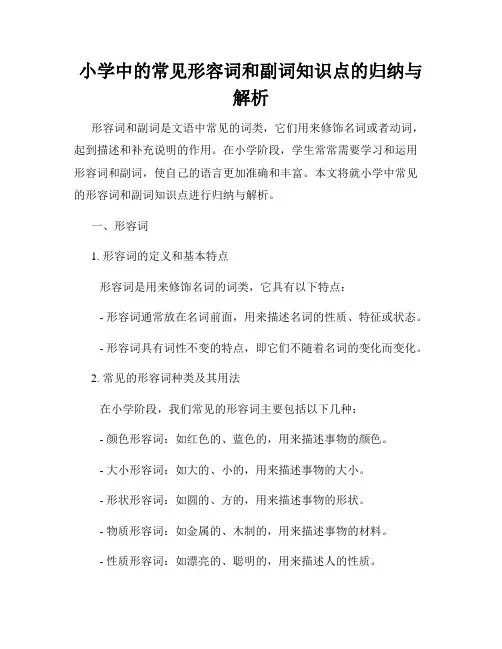
小学中的常见形容词和副词知识点的归纳与解析形容词和副词是文语中常见的词类,它们用来修饰名词或者动词,起到描述和补充说明的作用。
在小学阶段,学生常常需要学习和运用形容词和副词,使自己的语言更加准确和丰富。
本文将就小学中常见的形容词和副词知识点进行归纳与解析。
一、形容词1. 形容词的定义和基本特点形容词是用来修饰名词的词类,它具有以下特点:- 形容词通常放在名词前面,用来描述名词的性质、特征或状态。
- 形容词具有词性不变的特点,即它们不随着名词的变化而变化。
2. 常见的形容词种类及其用法在小学阶段,我们常见的形容词主要包括以下几种:- 颜色形容词:如红色的、蓝色的,用来描述事物的颜色。
- 大小形容词:如大的、小的,用来描述事物的大小。
- 形状形容词:如圆的、方的,用来描述事物的形状。
- 物质形容词:如金属的、木制的,用来描述事物的材料。
- 性质形容词:如漂亮的、聪明的,用来描述人的性质。
- 时态形容词:如新的、旧的,用来描述事物的年代或时期。
3. 形容词的用法注意事项在运用形容词时,需要注意以下几点:- 形容词要和被修饰的名词保持一致,即形容词的单复数和被修饰的名词一致。
- 形容词在句子中的位置通常是紧靠在名词前面,但有时也可以放在句子的其它位置以达到修饰的效果。
- 形容词可以通过加上后缀来构成比较级和最高级,对事物进行比较。
二、副词1. 副词的定义和基本特点副词是用来修饰动词、形容词、副词和整个句子的词类,它具有以下特点:- 副词可以用来修饰动词的动作方式、程度和频率。
- 副词通常放在动词或形容词的后面,用来对其进行修饰。
- 副词的比较级和最高级可以通过在前面加上more和most来构成。
2. 常见的副词种类及其用法在小学阶段,我们常见的副词主要包括以下几种:- 方式副词:如慢慢地、高兴地,用来描述动作的方式。
- 程度副词:如非常、很,用来表示动作的程度。
- 频率副词:如常常、从不,用来表示动作的频率。
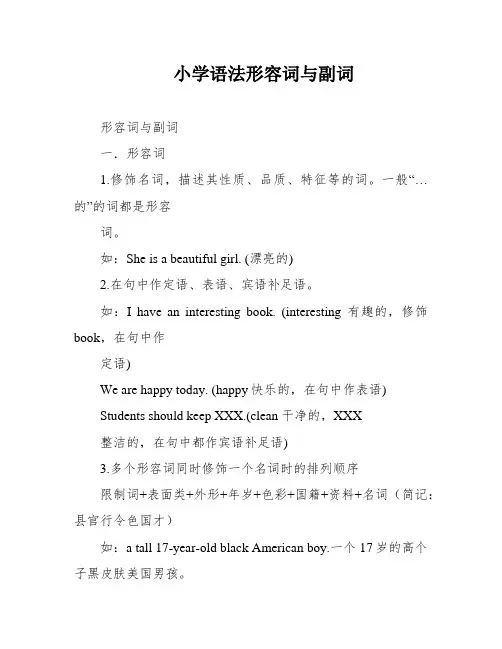
小学语法形容词与副词形容词与副词一.形容词1.修饰名词,描述其性质、品质、特征等的词。
一般“…的”的词都是形容词。
如:She is a beautiful girl. (漂亮的)2.在句中作定语、表语、宾语补足语。
如:I have an interesting book. (interesting有趣的,修饰book,在句中作定语)We are happy today. (happy快乐的,在句中作表语)Students should keep XXX.(clean干净的,XXX整洁的,在句中都作宾语补足语)3.多个形容词同时修饰一个名词时的排列顺序限制词+表面类+外形+年岁+色彩+国籍+资料+名词(简记:县官行令色国才)如:a tall 17-year-old black American boy.一个17岁的高个子黑皮肤美国男孩。
the big round red wooden table.又大又圆的红色木质饭桌。
二.副词:1.通常修饰动词,表示动作的程度、方式等。
还可修饰形容词、副词,有时修饰整个句子,在句中作状语。
一般“…地”的词都是副词。
如:You must listen to the XXX.(细致地,当真地)2.副词的分类1)时间副词: now, today等2)频度副词:always, usually, often, sometimes, seldom, never2)地点副词:here, there, upstairs, downstairs等3)方式副词:carefully, fast, well, politely等4)程度副词: much, little, quite等5)疑问副词: how, when, where, why等三.形容词转化成副词1.普通在描绘词后加ly,如:quick-quickly2.以子音字母+y末端的描绘词,变y为i,加ly,如:happy-happily3.以ue结尾的形容词,去e加ly,如:true-XXX注:有些词兼无描绘词和副词的词性,如:fast, hard, high, late, far等,它们的词性只有通过具体语境来判断。
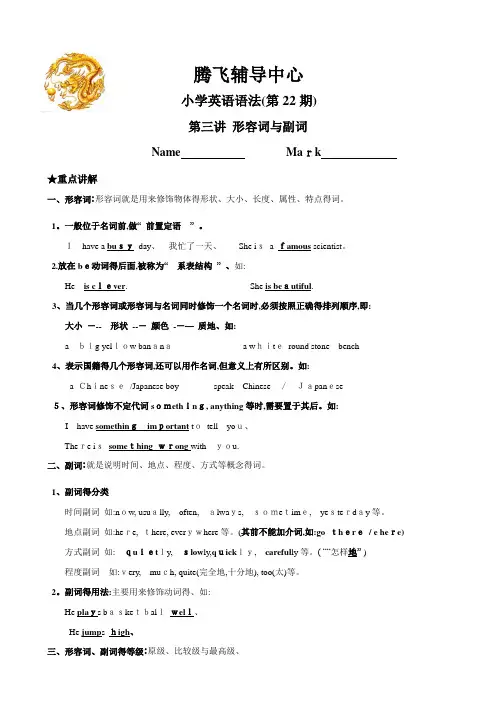
腾飞辅导中心小学英语语法(第22期)第三讲形容词与副词Name Mark★重点讲解一、形容词:形容词就是用来修饰物体得形状、大小、长度、属性、特点得词。
1。
一般位于名词前,做“ 前置定语” 。
Ihave a busyday、我忙了一天、She isa famous scientist。
2.放在be动词得后面,被称为“系表结构” 、如:He is clever. She is beautiful.3、当几个形容词或形容词与名词同时修饰一个名词时,必须按照正确得排列顺序,即:大小---形状---颜色--—质地、如:abig yellow banana a whiteround stone bench4、表示国籍得几个形容词,还可以用作名词,但意义上有所区别。
如:a Chinese/Japanese boy speak Chinese/Japanese5、形容词修饰不定代词something, anything等时,需要置于其后。
如:I have somethingimportant totell you、There issomething wrong withyou.二、副词:就是说明时间、地点、程度、方式等概念得词。
1、副词得分类时间副词如:now, usually,often,always,sometime,yesterday等。
地点副词如:here, there, everywhere等。
(其前不能加介词,如:go there/ e here)方式副词如:quietly,slow ly,quickly,careful ly等。
( ““怎样地” )程度副词如:very,much, quite(完全地,十分地), too(太)等。
2。
副词得用法:主要用来修饰动词得、如:He plays basketballwell、He jump shigh、三、形容词、副词得等级:原级、比较级与最高级、1、原级得用法肯定句:主语+ be动词+as + 原级+as 。
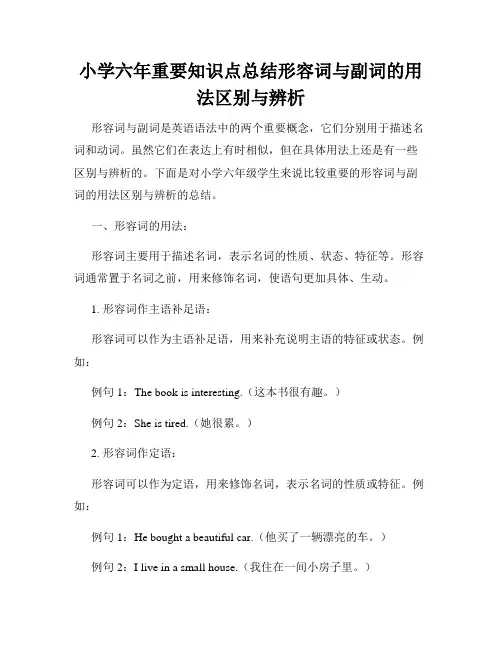
小学六年重要知识点总结形容词与副词的用法区别与辨析形容词与副词是英语语法中的两个重要概念,它们分别用于描述名词和动词。
虽然它们在表达上有时相似,但在具体用法上还是有一些区别与辨析的。
下面是对小学六年级学生来说比较重要的形容词与副词的用法区别与辨析的总结。
一、形容词的用法:形容词主要用于描述名词,表示名词的性质、状态、特征等。
形容词通常置于名词之前,用来修饰名词,使语句更加具体、生动。
1. 形容词作主语补足语:形容词可以作为主语补足语,用来补充说明主语的特征或状态。
例如:例句1:The book is interesting.(这本书很有趣。
)例句2:She is tired.(她很累。
)2. 形容词作定语:形容词可以作为定语,用来修饰名词,表示名词的性质或特征。
例如:例句1:He bought a beautiful car.(他买了一辆漂亮的车。
)例句2:I live in a small house.(我住在一间小房子里。
)3. 形容词作表语:形容词可以作为表语,用来补充说明主语的状态或特征。
例如:例句1:The weather today is sunny.(今天的天气很晴朗。
)例句2:She is happy.(她很快乐。
)二、副词的用法:副词主要用于描述动词,表示动作的方式、时间、程度等。
副词通常置于动词之前或句末,用来修饰动词,使语句更加具体、明确。
1. 副词修饰动词:副词可以修饰动词,表示动作的方式、频率等。
例如:例句1:He runs quickly.(他跑得很快。
)例句2:We often play football.(我们经常踢足球。
)2. 副词修饰形容词:副词也可以修饰形容词,表示程度或程度的变化。
例如:例句1:She is very beautiful.(她非常漂亮。
)例句2:He is quite tired.(他很累。
)3. 副词修饰副词:副词也可以修饰副词,表示程度、频率等。
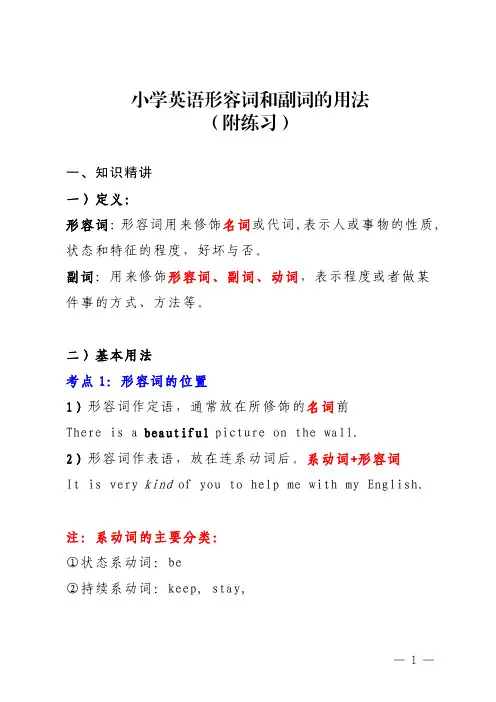
小学英语形容词和副词的用法(附练习)一、知识精讲一)定义:形容词:形容词用来修饰名词或代词,表示人或事物的性质,状态和特征的程度,好坏与否。
副词:用来修饰形容词、副词、动词,表示程度或者做某件事的方式、方法等。
二)基本用法考点1:形容词的位置1)形容词作定语,通常放在所修饰的名词前There is a beautiful picture on the wall.2)形容词作表语,放在连系动词后。
系动词+形容词It is very kind of you to help me with my English.注:系动词的主要分类:①状态系动词:be②持续系动词:keep,stay,③表像系动词:seem,look④感官系动词:feel,smell,sound,taste⑤变化系动词:become,grow,turn,get,go,come,run, fall考点2:副词的位置1)修饰动词作状语①多数位于动词之后,及物动词的宾语或介词的宾语之后。
The farmers are working hard in the field.The nurse looks after the babies carefully.②频度副词放在动词前,情态动词和助动词之后。
He always goes to school On foot.She was often late for school.2)修饰形容词作状语,放在形容词前。
He has a very nice watch.The box is too heavy.考点3:副词的分类频度副词:often,always,usually,seldom,never, sometimes.地点副词:here,there,everywhere,anywhere,inside, outside,back,home...方式副词:carefully,suddenly,normally,fast,well,程度副词:much,little,very,rather,so,too,quite, perfectly,almost.考点4:形容词变副词注意:①常见形容词副词同形的有:hard,fast,early,high等②有些单词以“ly”结尾,是形容词,常见的有:ugly,lovely, friendly,silly等考点5:比较级、最高级的变化规则变化不规则变化考点6:比较级、最高级的用法一、原级的用法①肯定句用“as+原级形容词+as”结构,表示两者的情况一样如:Mary is as tall as her sister.②否定句用“not as/so+原级形容词+as”结构,表示后者不如前者如:It is not as/so warm as it was yesterday.二、比较级的用法比较级句型:主语A+谓语动词+形/副比较级+than+B A……比B……如:He is older than me.他比我年长。
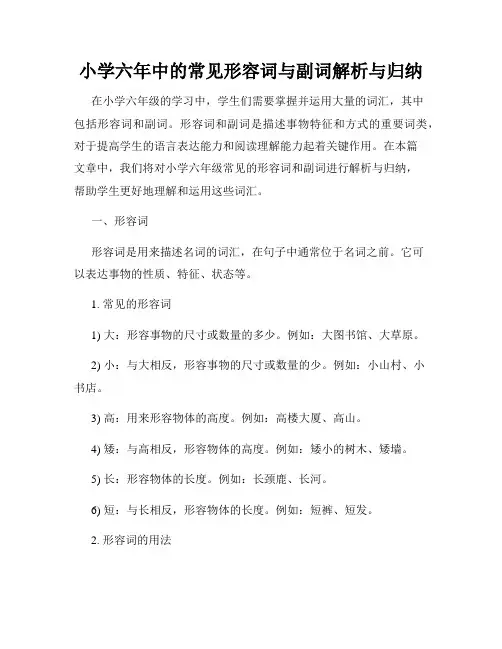
小学六年中的常见形容词与副词解析与归纳在小学六年级的学习中,学生们需要掌握并运用大量的词汇,其中包括形容词和副词。
形容词和副词是描述事物特征和方式的重要词类,对于提高学生的语言表达能力和阅读理解能力起着关键作用。
在本篇文章中,我们将对小学六年级常见的形容词和副词进行解析与归纳,帮助学生更好地理解和运用这些词汇。
一、形容词形容词是用来描述名词的词汇,在句子中通常位于名词之前。
它可以表达事物的性质、特征、状态等。
1. 常见的形容词1) 大:形容事物的尺寸或数量的多少。
例如:大图书馆、大草原。
2) 小:与大相反,形容事物的尺寸或数量的少。
例如:小山村、小书店。
3) 高:用来形容物体的高度。
例如:高楼大厦、高山。
4) 矮:与高相反,形容物体的高度。
例如:矮小的树木、矮墙。
5) 长:形容物体的长度。
例如:长颈鹿、长河。
6) 短:与长相反,形容物体的长度。
例如:短裤、短发。
2. 形容词的用法形容词可以单独使用,也可以与系动词连用,表示事物的状态、特征等。
例如:1) 这只狗很聪明。
2) 我的新书很有趣。
在句子中,形容词也可以被修饰,用来加强形容词的程度。
例如:1) 这只狗非常聪明。
2) 我的新书非常有趣。
二、副词副词是用来描述动词、形容词、副词等词类的词汇,在句子中通常位于动词之前或句末。
它可以表达动作的方式、程度、时间等。
1. 常见的副词1) 很:表示程度的副词,用来修饰形容词或副词。
例如:很高兴、很快。
2) 非常:表示程度的副词,用来修饰形容词或副词,比很更强烈。
例如:非常漂亮、非常快。
3) 总是:表示频率的副词,表示经常发生的动作或状态。
例如:他总是迟到。
4) 有时候:表示频率的副词,表示偶尔发生的动作或状态。
例如:有时候我喜欢看书,有时候我喜欢玩游戏。
5) 现在:表示时间的副词,表示当前的动作或状态。
例如:他正在现在做作业。
2. 副词的用法副词可以修饰动词、形容词或其他副词。
例如:1) 她跑得很快。
2) 这个问题非常困难。
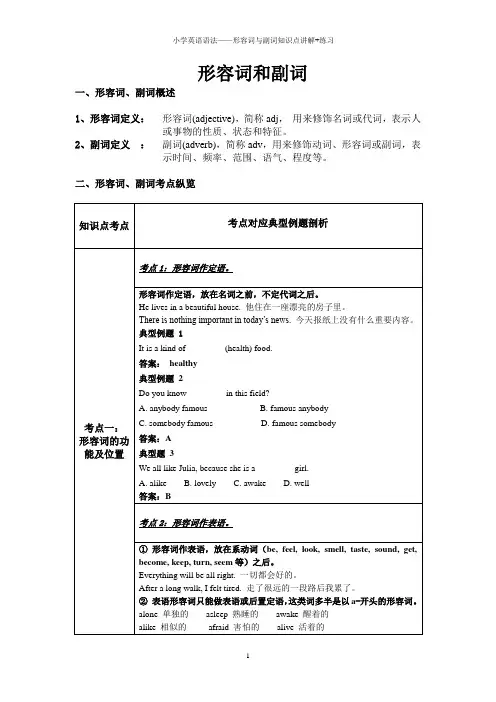
形容词和副词一、形容词、副词概述1、形容词定义:形容词(adjective),简称adj,用来修饰名词或代词,表示人或事物的性质、状态和特征。
2、副词定义:副词(adverb),简称adv,用来修饰动词、形容词或副词,表示时间、频率、范围、语气、程度等。
二、形容词、副词考点纵览三、综合练习( ) 1. How beautifully she sings! I have never heard _____ voice.A. a betterB. a bestC. the betterD. the best ( ) 2. She looks very _____ but I can’t remember her name.A. similarB. familiarC. friendlyD. strange ( ) 3. Children all looked _____ at the broken model plane and felt quite _____.A. sad; sadB. sadly; sadlyC. sad; sadlyD. sadly; sad( ) 4. The child dreamed that he had once lived in a _______ house in the forest.A. wooden pretty littleB. little pretty woodenC. pretty little woodenD. wooden little pretty( ) 5. ---Which team is _______ to win the game?---I don’t know, but I’ve found _______ for ours to win.A. probable; it unlikelyB. likely; it possibleC. possible; it possibleD. likely; it possibly( ) 6. With the development of the Internet, _______ communication is done by regular mail.A. lessB. moreC. littleD. few( ) 7. ---If you don’t like the red coat, take the blue one.---OK, but do you have ______ size in blue? This one’s a bit tight for me.A. a bigB. a biggerC. the bigD. the bigger( ) 8. If there were no examinations, we should have ______ at school.A. the happiest timeB. a more happier timeC. much happiest timeD. a much happier time( ) 9. This dress is prettier, but it costs ______ that one.A. twice more thanB. twice as much asC. as much twice asD. twice so much as( ) 10.________students are required to take part in the boat race.A. Ten strong young ChineseB. Ten Chinese strong youngC. Chinese ten young strongD. Young strong ten Chinese( ) 11. Allen had to call a taxi because the box was ____to carry all the way home.A. much too heavyB. too much heavyC. heavy too muchD. too heavy much( ) 12. Our neighbor has ________ours.A. as a big house asB. as big a house asC. the same big house asD. a house the same big as( ) 13. We were in ________when we left that we forgot the airline tickets.A. a rush so anxiousB. a such anxious rushC. so an anxious rushD. such an anxious rush( ) 14. ---I was riding along the street and all of a sudden, a car cut in and knocked me down.---You can never be ________careful in the street.A. muchB. veryC. soD. too( ) 15. ---You don’t look very ________.Are you ill?---No,I’m just a bit tired.A. goodB. wellC. strongD. healthy( ) 16. Four of Robert’s children were at the party,including ________, Luke.A. the eldestB. an oldest oneC. the oldD. an old one( ) 17. Many students signed up for the ________race in the sports meeting to be held next week.A. 800-metre-longB. 800-metres-longC. 800 metre lengthD. 800 metres length( ) 18. It’s always difficult being in a foreign country,________if you don’t speak the language.A. extremelyB. naturallyC. basicallyD. especially( ) 19. In recent years,travel companies have succeeded in selling us the idea that the further we go,__________.A. our holiday will be betterB. our holiday will be the betterC. the better our holiday will beD. the better will our holiday be( ) 20. When he heard a cry for help, he ran out as ________ as he could.A. hardlyB. quicklyC. finallyD. slowly( ) 21. “Our team is _____ to win the match.” “Really? But I don’t think so.”A. easyB. difficultC. possibleD. sure( ) 22. A ______ road goes ______ from one place to another.A. straight; straightB. straightly; straightlyC. straight; straightlyD. straightly; straight( ) 23. “This book is ______ more useful for us students.” “Yes, but it is _______ too difficult.”A. quite; quiteB. much; ratherC. rather; quite D quite; much( ) 24. There was a ______ change in the weather, and the rain came pouring down.A. quickB. slowC. fastD. sudden( ) 25. You can speak ______ in front of him, but you can’t eat ______ in his restaurant.A. freely; freelyB. free; freelyC. freely; freeD. free; free( ) 26. Tom will not be at the picnic, ______ to the family’s disappointment.A. muchB. moreC. too muchD. much more( ) 27. --- I have seen so little of Mike ______. Is he away on business?--- Oh, no. He just leaves for his office early and comes back very ______.A. later; latelyB. later; laterC. lately; lateD. late; lately( ) 28. From his ______ voice on the phone I know everything is well under way.A. satisfactoryB. satisfyingC. satisfiedD. satisfaction( ) 29. In ______ Chinese culture, marriage decisions were often made by parents for their children.A. traditionalB. historicC. peacefulD. civil( ) 30. The houses in the village are ______ built of wood and hay.A. mostB. almostC. nearlyD. mostly( ) 31. --- What do people wear when they go to the theatre?--- Well, it isn’t very ______. People can wear anything they like.A. normalB. certainC. modernD. simple( ) 32. Mary’s biology is ______ than ______ in the class.A. a lot of better; anyone else’sB. far better; anyone’s else’sC. much better; anyone elseD. a lot better; anyone else’s( ) 33. We decided not to climb the mountains because it was raining ____.A. badlyB. hardlyC. stronglyD. heavily( ) 34. Paris is one of _____ cities in the world.A. more beautifullyB. more beautifulC. the most beautifullyD. the most beautiful ( ) 35. Are you going to leave______?A. the open windowsB. the windows openingC. the windows openD. the windows opened( ) 36. Bob never does his homework _____ Mary, so he makes lots of mistakes.A. so careful asB. as carefully asC. carefully asD. as careful as.( ) 37. My sister is good at sports. She can jump ____ than me.A. highestB. very highC. too highD. much higher ( ) 38. When spring comes, the trees get ____.A. green and greenB. green and greenerC. greener and greenD. greener and greener( ) 39.He works very ___________.He _____________has a rest on Sundays.A. hard; hardlyB. hardly; hardC. hard; hardD. hardly; hardly( ) 40.He learns Russian_____________.A. goodB. niceC. wellD. fine( ) 41.The boy didn’t run______________ to catch the bus.A. fast enoughB. enough fastC. quick enoughD. enough quickly ( ) 42.Eating _____________ is bad for our health.A. much tooB. too muchC. too moreD. too many( ) 43.Have you ever seen ______________ big panda before?A. a suchB. such aC. so aD. as( ) 44.He looks very _____________ today.A. worriedB. worryC. worryingD. to worry( ) 45.Listen to me. I have _____________ to tell you.A. important somethingB. important anythingC. something importantD. anything important( ) 46. ---How ___ can you finish the drawing?--- In ten minutes.A. longB. often.C. soonD. rapid( ) 47. This book is _____ worth seeing again.A. veryB. quiteC. wellD. much( ) 48. My _____ brother is three years ____ than I .A. old; olderB. elder; olderC. older; elderD. old; elder( ) 49. We felt ___ after we watched the ___ football match.A. exciting; excitedB. excited; excitingC. excited; excitedD. exciting; exciting( ) 50. The old man lived ____ in the house, but he didn’t feel___.A. lonely; lonelyB. alone; lonelyC. alone; aloneD. lonely; alone小学英语语法——形容词与副词知识点讲解+练习参考答案1. A2.B3.D4.C5.B6.A7.B8.D9.B 10.A 11. A 12.B 13.D 14.D 15.B 16.A 17.A 18.D 19.C 20.B 21. D 22.A 23.B 24.D 25.C 26.A 27.C 28.C 29.A 30.D 31. B 32.D 33.D 34.D 35.C 36.B 37.D 38.D 39.A 40.C 41. A 42.B 43.B 44.A 45.C 46.C 47.C 48.B 49.B 50.B11。
形容词*题型: 形容词比较级和最高级的单选题、阅读题、句型转换题和英汉互译题。
(一)概念形容词是说明人或事物的属性、状态或特征的词,在句子中主要作名词或代词的装饰语。
形容词通常置于其修饰的名词或代词之前,并且多数形容词具有比较等级。
(二)比较级、最高级绝大多数形容词有三种形式,原级,比较级和最高级,以表示形容词说明的性质在程度上的不同。
1.规则变化2.不规则变化(三)用法1. 形容词比较级用于两个(=2)人或事物的比较,其结构形式如下:主语+ 谓语(系动词) + 形容词比较级+ than + 对比成分e.g. Today is warmer than yesterday. 今天的天气比昨天暖和。
This picture is more beautiful than that one. 这张照片比那张照片漂亮。
2.形容词最高级用于两个以上(≥2)的人和物进行比较,其结构形式为:主语+谓语(系动词)+the+形容词最高级+名词+表示范围的内容e.g. Shanghai is the biggest city in China. 上海是中国最大的城市。
He is the tallest of the three boys. 他是这3个男孩子中最高的。
3.一个事物的逐渐增长或减少用两个由and连接的比较级表示,表“越来越...”:e.g. The weather is getting colder and colder. 天气越来越冷了。
*但注意:如果多音节词用此结构时应为more and more +形容词:e.g. more and more beautiful 越来越漂亮*形容词、副词用法区别记忆口诀1.形名——形容词修饰名词e.g:a young girl2.系形——*系动词后面跟形容词(系动词:be动词、become、look、feel、smell、taste...)e.g:is lovely (可爱的) looks nice3.动副——副词修饰动词e.g:run quickly4.副形——副词修饰形容词e.g:very good副词(一)概念是指在句子中表示行为或状态特征的词,修饰动词、形容词或整句。